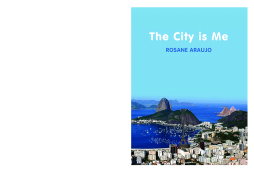
Additional Information
Book Details
Abstract
The result of extensive research about our notions of the city and the person throughout time, The City is Me explores the technology, research findings, and new ideas that have made it impossible to sustain conceptions of the city that are based on the criterion of a boundary. Showing how this shift mirrors the decentralization and fragmentation of personal identity in a globalized world, Rosane Araujo confronts the challenge of rethinking urbanism in a way that corresponds to the risk and uncertainty – but also to the possibilities – of today’s cities. The City is Me proposes an intriguing new approach to the understanding of the relationship between the city and personal identity.
Table of Contents
| Section Title | Page | Action | Price |
|---|---|---|---|
| FontCover | FC | ||
| Half-title | i | ||
| Title | iii | ||
| Copyright | iv | ||
| Dedication | v | ||
| Contents | vii | ||
| ACKNOWLEDGEMENTS | xi | ||
| PREFACE | xiii | ||
| INTRODUCTION | 1 | ||
| General Structure of this book | 12 | ||
| CHAPTER 1 — ABOUT CONCEPT | 13 | ||
| 1.1 The concept of City | 18 | ||
| 1.2 The city | 19 | ||
| CHAPTER 2 — RECONCEPTUALIZING THE CITY | 21 | ||
| 2.1 The informational city | 24 | ||
| 2.2 The videocity | 27 | ||
| 2.3 The metapolis | 28 | ||
| 2.4 The megacities | 28 | ||
| 2.5 The global city | 29 | ||
| 2.6 The cybercity | 29 | ||
| 2.7 The e-topia | 30 | ||
| 2.8 The nodal city | 32 | ||
| 2.9 The city of bits | 33 | ||
| 2.10 The ecstacity | 40 | ||
| 2.11 Other concepts of city | 44 | ||
| CHAPTER 3 — URBANISM IN FLUID STATE | 47 | ||
| 3.1 Brief introduction to topology | 50 | ||
| 3.2 A form that creates its permanent mutation | 52 | ||
| 3.3 The twenty-first century Orbanism | 56 | ||
| CHAPTER 4 — RECONCEPTUALIZING I | 59 | ||
| 4.1 René Descartes | 62 | ||
| 4.1.1 Cartesian Philosophy and the foundation issue | 62 | ||
| 4.1.2 Subject as foundation: I-substance | 62 | ||
| 4.1.3 Subject as a first-person consciousness | 63 | ||
| 4.1.4 Subject of reflection | 64 | ||
| 4.1.5 The Cartesian I: I-subject | 64 | ||
| 4.2 Immanuel Kant | 65 | ||
| 4.2.1 The Copernican revolution and the critical project | 65 | ||
| 4.2.2 The Kantian transcendental subject | 66 | ||
| 4.3 Sigmund Freud | 68 | ||
| 4.3.1 Freud and Psychoanalysis | 68 | ||
| 4.3.2 Unconscious and consciousness: the Freudian topography | 69 | ||
| 4.3.3 Ego: das Ich | 72 | ||
| 4.4 The systemic thinking of Ludwig von Bertalanffy | 73 | ||
| 4.5 The systemic thinking of Maturana and Varela: the concept of autopoiesis | 78 | ||
| 4.5.1 Unity, closure and coupling | 78 | ||
| 4.5.2 The human knowledge | 83 | ||
| 4.6 Gilles Deleuze and Félix Guattari´s rhizome | 85 | ||
| 4.7 The cognitive ecology of Pierre Lévy | 87 | ||
| 4.7.1 The couplings of space-time | 88 | ||
| 4.7.2 Virtualizations | 91 | ||
| 4.8 Complex networks | 95 | ||
| 4.8.1 Random networks | 96 | ||
| 4.8.2 Scale-free networks | 97 | ||
| 4.9 Summary chart | 98 | ||
| 4.10 Considerations | 101 | ||
| CHAPTER 5 — THE CONCEPT OF PERSON ACCORDING TO THE NEW PSYCHOANALYSIS | 105 | ||
| 5.1 The equivalence I = Person | 108 | ||
| 5.2 Person = Primary Formations + Secondary Formations + Original Formation | 112 | ||
| 5.2.1 Primary Formations | 112 | ||
| 5.2.2 Secondary Formations | 114 | ||
| 5.2.3 Original Formation | 115 | ||
| 5.3 Persons are IdioFormations of our case | 116 | ||
| 5.3.1 Haver | 117 | ||
| 5.3.2 The Person “is” in the order of “Being” and “há” in the order of “Haver” | 118 | ||
| 5.4 Person is a Pole with Focus, Fringe and Background | 119 | ||
| 5.5 Negative definitions of I = Person | 121 | ||
| 5.6 Without frontiers | 123 | ||
| CHAPTER 6 — THE CITY IS ME | 127 | ||
| 6.1 The city is me: pole, focus, fringe | 131 | ||
| 6.2 The urban pole in focus and fringe | 133 | ||
| CHAPTER 7 — CONCLUSION | 137 | ||
| Bibliography | 145 | ||
| NOTES | 155 | ||
| AUTHORS INDEX | 175 | ||
| BackCover | BC |
